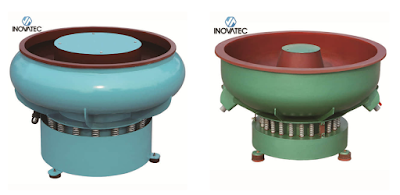Vibratory Deburring Machine for Mass Finishing
Mass finishing is not limited to
the process of small parts. It can also be used, for example, in the
surface finishing of aeronautical components with a length of up to 6
m. Today many parts are still manually deburred after machining. This
requires highly specialized personnel to prevent damage to valuable
components. The vibratory deburring
machine offers 100% repeatability, high quality solutions that can be
adapted to every need. The larger pieces are usually processed in
rectangular vibrators. To prevent collisions between the pieces, spacers
are installed in the rectangular vibrators, so that the pieces are processed
individually in each separation of the vibrator.
The foundry industry
uses numerous technologies to make a multitude of pieces effectively. New
alloys and constantly refined foundry methods offer new applications to
foundries. Frequently, castings require a surface finish, such as
deburring or radiusing. Another important finishing process is the general
cleaning of the castings, including the removal of remains from the
mold. Other surface finishing processes is the preparation to paint and
the creation of a 'pre-coat' finish. The metals of light alloys,
non-ferrous metals, iron, steel, and stainless steel often need a surface
finishing process.
Aluminum, magnesium and zinc smelters normally
use continuous vibration finishing systems. The deburring can be done in a
process time of 5 to 8 minutes. The advantage of the vibratory deburring machines is the elimination of burrs and
remains of the mold leaving the surface homogeneous. Continuous vibrators
are available in circular or linear systems (long radius or multi
channel). While the linear systems allow the treatment of pieces with
dimensions up to 800 mm, the circular systems are ideal for pieces no larger
than 350 mm. Finishing systems can be easily adapted to casting and
stamping cells, thus achieving a fully automatic and effective finishing
process.
The mass
finishing requires the use of water and compounds. Recycling systems
allow the reuse of the water / compound mixture, thus reducing consumption to a
minimum; which translates into a considerable saving of compound and
water, thus contributing to the environment.
Deburring, edge cutting or radiating in a short process time
represents only a small part of the mass
finishing technology range. Other applications are the refining and
polishing of parts such as hip or knee implants, brass and stainless steel
ornaments for bathrooms, or handles for doors and windows.
Frequently, in many cases a polishing process prior to mass finishing is applied. The
subsequent bulk finishing process can achieve mirror polishing surfaces with
values of less than 0.2 μm. Depending on their geometry, size and
condition of the surface of the pieces, you can use circular or rectangular
vibrators, high-energy systems with centrifugal force and Drag or Plunge
systems. Depending on the size of the pieces and type of machine, large
quantities of pieces can be treated simultaneously. This minimizes the
time losses in handling as well as loading and unloading.
Follow us on Our
Social Profiles Links:



Comments
Post a Comment